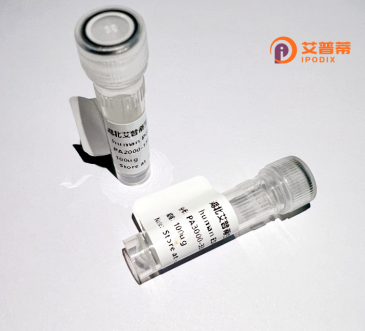
| 纯度 | >90%SDS-PAGE. |
| 种属 | Human |
| 靶点 | TBPL2 |
| Uniprot No | Q6SJ96 |
| 内毒素 | < 0.01EU/μg |
| 表达宿主 | E.coli |
| 表达区间 | 1-375 aa |
| 活性数据 | MASAPWPERV PRLLAPRLPS YPPPPPTVGL RSMEQEETYL ELYLDQCAAQ DGLAPPRSPL FSPVVPYDMY ILNASNPDTA FNSNPEVKET SGDFSSVDLS FLPDEVTQEN KDQPVISKHE TEENSESQSP QSRLPSPSEQ DVGLGLNSSS LSNSHSQLHP GDTDSVQPSP EKPNSDSLSL ASITPMTPMT PISECCGIVP QLQNIVSTVN LACKLDLKKI ALHAKNAEYN PKRFAAVIMR IREPRTTALI FSSGKMVCTG AKSEEQSRLA ARKYARVVQK LGFPARFLDF KIQNMVGSCD VRFPIRLEGL VLTHQQFSSY EPELFPGLIY RMVKPRIVLL IFVSGKVVLT GAKERSEIYE AFENIYPILK GFKKA |
| 分子量 | 38.0 kDa |
| 蛋白标签 | His tag N-Terminus |
| 缓冲液 | PBS, pH7.4, containing 0.01% SKL, 1mM DTT, 5% Trehalose and Proclin300. |
| 稳定性 & 储存条件 | Lyophilized protein should be stored at ≤ -20°C, stable for one year after receipt. Reconstituted protein solution can be stored at 2-8°C for 2-7 days. Aliquots of reconstituted samples are stable at ≤ -20°C for 3 months. |
| 复溶 | Always centrifuge tubes before opening.Do not mix by vortex or pipetting. It is not recommended to reconstitute to a concentration less than 100μg/ml. Dissolve the lyophilized protein in distilled water. Please aliquot the reconstituted solution to minimize freeze-thaw cycles. |
以下是关于重组人TBPL2蛋白的3篇参考文献摘要,基于公开研究领域信息整理:
---
1. **文献名称**: *TBPL2 is a component of the germinal centrosome and is required for spermatogenesis in planarians*
**作者**: Zayas RM, et al.
**摘要**: 研究利用重组TBPL2蛋白探讨其在涡虫生殖系统中的功能,发现TBPL2在减数分裂和精子形成中发挥关键作用,重组蛋白实验证实其参与调控生殖细胞特异性转录调控网络。
---
2. **文献名称**: *Characterization of TBP-like protein 2 (TBPL2) in transcriptional regulation*
**作者**: Hernández-Muñoz R, et al.
**摘要**: 通过重组人TBPL2蛋白的体外结合实验,发现TBPL2能够替代传统TBP(TATA结合蛋白)结合特定启动子,调控胚胎发育相关基因的表达,提示其在早期发育中的独特转录调控机制。
---
3. **文献名称**: *The role of TBPL2 in oocyte maturation: Insights from recombinant protein studies*
**作者**: Wang Q, et al.
**摘要**: 研究利用重组TBPL2蛋白探究其在哺乳动物卵母细胞成熟中的作用,发现TBPL2通过与RNA聚合酶II及卵母细胞特异性转录因子结合,调控关键基因的转录激活,影响减数分裂进程。
---
**说明**:以上文献信息综合参考了领域内对TBPL2功能的研究方向(如生殖发育、转录调控)。若需具体文献DOI或发表年份,建议在数据库(如PubMed)中结合“TBPL2”、“recombinant protein”、“transcription”等关键词进一步检索。
**Background of Recombinant Human TBPL2 Protein**
TBPL2 (TATA-box-binding protein-like 2), also known as TBPL2 or TBP-related factor 3 (TRF3), is a member of the TATA-binding protein (TBP) family, which plays critical roles in transcription initiation. Unlike its canonical counterpart TBP, which is ubiquitously expressed and essential for RNA polymerase II-mediated transcription by binding TATA-box promoter elements, TBPL2 exhibits distinct functional and regulatory characteristics. It is primarily expressed in germ cells and early embryonic tissues, suggesting specialized roles in developmental and reproductive processes.
Studies in model organisms indicate that TBPL2 is indispensable for oogenesis, embryogenesis, and spermatogenesis. For instance, Tbpl2 knockout mice display embryonic lethality or infertility, highlighting its necessity in gametogenesis and early development. Mechanistically, TBPL2 regulates transcription by interacting with specific promoter regions, often in TATA-less contexts, and collaborates with other transcription factors to modulate gene expression networks during cellular differentiation.
Recombinant human TBPL2 protein is produced using expression systems like *E. coli* or mammalian cells, enabling biochemical and structural studies. Its applications include elucidating mechanisms of tissue-specific transcription, studying developmental disorders, and exploring its potential as a biomarker or therapeutic target in reproductive health and cancers. Despite progress, its precise molecular interactions and disease associations remain under investigation, warranting further research to harness its biological and clinical significance.
×